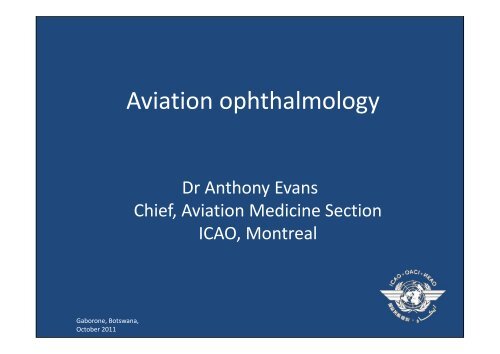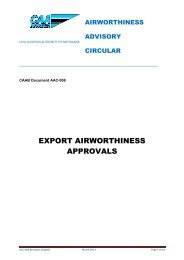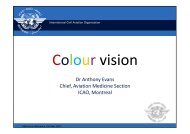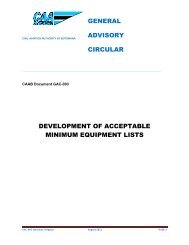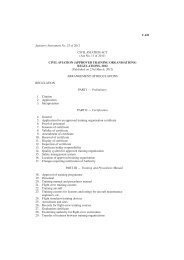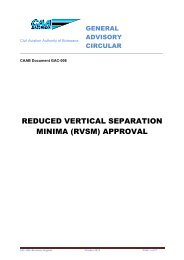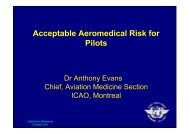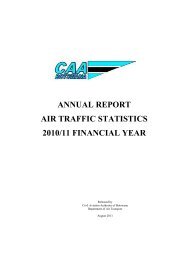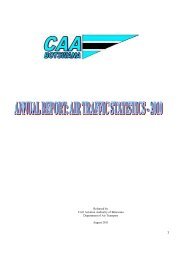Aviation ophthalmology
Aviation ophthalmology
Aviation ophthalmology
Create successful ePaper yourself
Turn your PDF publications into a flip-book with our unique Google optimized e-Paper software.
<strong>Aviation</strong> <strong>ophthalmology</strong><br />
Dr Anthony Evans<br />
Chief, <strong>Aviation</strong> Medicine Section<br />
ICAO, Montreal<br />
Gaborone, Botswana,<br />
October 2011
Plan<br />
• Visual acuity<br />
– Myopia<br />
– Hypermetropia<br />
• Spectacle prescription<br />
• Peripheral fields<br />
• Cases
6.3.3 Visual requirements<br />
Class 1<br />
6.3.3.2 Distant visual acuity with or without correction shall be<br />
6/9 or better in each eye separately, and binocular visual<br />
acuity shall be 6/6 or better. No limits apply to uncorrected<br />
visual acuity. Where this standard of visual acuity can be<br />
obtained only with correcting lenses, the applicant may be<br />
assessed as fit provided that:<br />
a) such correcting lenses are worn during the exercise of the<br />
privileges of the licence or rating applied for or held; and<br />
b) in addition, a pair of suitable correcting spectacles is kept<br />
readily available during the exercise of the privileges of the<br />
applicant’s licence.<br />
[Spare pair of spectacles for near vision]<br />
[Acuity requirements for Class 2]
Visual acuity<br />
Myopia or hypermetropia<br />
Myopia (focus in front of retina, with fully relaxed lens)<br />
Corrected with a minus (concave) or plus (convex) lens
Visual acuity<br />
Myopia or hypermetropia<br />
Hypermetropia – focus behind retina with fully relaxed lens<br />
How do young people compensate<br />
Potential problems with excessive accommodation<br />
Corrected with a minus or plus lens
Astigmatism<br />
• Occurs when the cornea or lens is not<br />
symmetrical<br />
• Parallel rays of light are not brought to the<br />
same focus point by all regions of the<br />
cornea/lens<br />
• Corrected by<br />
– Cylindrical lens
Nomenclature<br />
• Meaning of 6/6<br />
– At 6 m the eye can see what is expected from the average<br />
eye at 6 m<br />
• Meaning of 6/12<br />
– At 6 m the eye can see what is expected from a normal eye<br />
at 12 m<br />
– i.e. vision is reduced below average<br />
• Meaning of 6/4<br />
– At 6 m the eye can see what is expected from a normal eye<br />
at 4 m<br />
– i.e. vision is improved above average
Namenclature<br />
• Meaning of 20/20<br />
– Same as 6/6, using feet rather than metres<br />
– At 20 feet, the eye can see what is expected from<br />
the average eye at 20 feet
Spectacle prescription
Cases (1)<br />
• Airline pilot, 55 years, 12,000 hours,<br />
firework accident<br />
–Distant VA: R = 6/5, L = 6/60
Cases (2)<br />
• Class 1 applicant, 23 years<br />
– Spectacle prescription:<br />
• R = -7.5, L = -6.5<br />
• Spectacle prescription 12 months post-LASIK<br />
• R = -1.5, L= -1.0, stable, no post-op complications
Cases (3)<br />
• R = + 7.5, L = + 6.5
Visual fields<br />
“3.3.5 The applicant shall be required to have normal fields of vision”.
Visual fields
Case (4)<br />
• 35 year old first officer. Myopic – 4.5 dioptres<br />
both eyes. Retinal detachment right eye<br />
March 2008. Treated by laser therapy – stable<br />
right upper quadrant visual field deficit in right<br />
eye. Left eye normal. Central vision in each<br />
eye = 6/5
Summary<br />
• Nomenclature<br />
• Myopia, hypermetropia<br />
• Perfect visual acuity not required<br />
• High refractive errors are acceptable if<br />
adequately corrected
<strong>Aviation</strong> <strong>ophthalmology</strong><br />
Dr Anthony Evans<br />
Chief, <strong>Aviation</strong> Medicine Section<br />
ICAO, Montreal<br />
Gaborone, Botswana,<br />
October 2011


